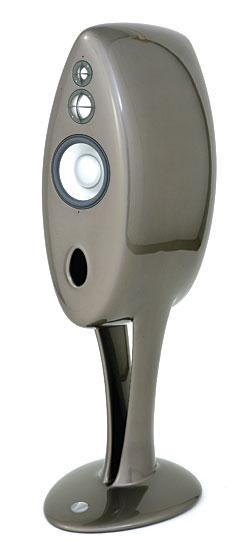| Columns Retired Columns & Blogs |
The Fifth Element #64 Page 2
I have a lot of ground to cover, and so I have space to give only a brief but equally enthusiastic recommendation of tenor Mark Padmore and fortepianist Kristian Bezuidenhout's new Dichterliebe: settings of Heinrich Heine verses by Robert Schumann and Franz Paul Lachner (CD, Harmonia Mundi HMU 907521, footnote 1). This one's a no-brainer—if you're familiar with Padmore's singing, you'll want this disc; if you're not, you should hear it. If you know Schumann's Liederkreis and Dichterliebe, you'll want this disc; if you don't, you should hear it. Amazon.com has sound bites up. Listen to the purity of Padmore's high notes in "I Wandered Under the Trees" and "Lovely Cradle of My Sorrows." Sure wish I could sing like that.
Footnote 1: Heine wrote not only romantic but political poetry as well. His most popular political poem, "The Silesian Weavers," is about the labor uprising of 1844 that gave its name to Pete Seeger's folk group, The Weavers.
Padmore's German accent seems very credible to this nonspeaker (but longtime hearer) of the language; the credited coach did well. The sound is so good that I at first thought this was an SACD. It was recorded by Brad Michel at London's AIR Lyndhurst Studios, which gave me a little jolt of cognitive dissonance. A particularly nice touch is that Kristian Bezuidenhout plays an 1837 Erard fortepiano. This is period-correct for this music, but more important, it does not sound like a thunky old PTA-room piano—it actually has some high frequencies. Some. It and Bezuidenhout's sensitive playing add much to the charm and drama of this program. Highly recommended. A no-brainer, in fact.
 Vivid Audio B-1 loudspeaker
Vivid Audio B-1 loudspeaker
In my October 2010 column, I heaped praise on Vivid Audio's entry-level floorstanding loudspeaker, the V-1.5 ($7650/pair)—despite its very weird looks. So, just as I then wrote that Wes Phillips' review of Vivid's top model, the G1 Giya, in the July 2010 issue was required reading to make the most sense of my remarks about the V-1.5, you might have to revisit my October coverage to make the most sense of these comments about the 3.5-way B-1.
I was of two minds about requesting the loan of the B-1s. First, at $15,000/pair, they're above my usual price range. More important, I was concerned that, given the greater complexity of a three-way crossover, the larger speaker, with tweeter, midrange, and woofers front and rear would not sound as beguilingly coherent as the two-way V-1.5, with its simpler crossover. I am delighted to report that I was quite wrong, and in more than one respect.
First of all, the B-1 is at least as coherent as the V-1.5. Neither the B-1's midrange nor its tweeter made itself apparent as separate sound sources. I'd been worried about nothing. And the presence of a dome midrange driver to handle the heart of the music meant that the B-1 was even more dynamically free than the entry-level model. It is also an easier, 4-ohm load to drive, which makes it seem more sensitive, although it is not. The B-1 is in every way a more capable speaker than the V-1.5, with no tradeoffs, save for costing twice as much.
What I truly was not expecting was that the coherence of the B-1's midrange revealed—but only in retrospect—a midrange coloration in the V-1.5: a very slight nasality or smearing that had not bothered me (and that therefore I had not taken note of). Crow duly eaten.
But I'm getting ahead of myself. From its appearance, the B-1 obviously is a Vivid product, but its overall visual impression is less jarring than that of the rather extraterrestrial V-1.5. The B-1 is a large speaker, but its bulk is cleverly disguised by its combination of an integral stand and an enclosure that is quite deep compared to its width. Another factor that makes the B-1 more friendly to interior décor is that its integral stand is not the monopod of the V-1.5 but a branched support, in art deco or streamliner style, that looks something like the throat of a hi-tech tennis racket.
The B-1 is 43" high, 10.4" wide at its widest point, and 14.75" deep. Its internal volume is 44 liters—exactly twice that of the V-1.5—and it weighs 84 lbs. The front baffle is vertically symmetrical about its mid-axis, and is more in the shape of a canoe or Zulu shield than the pod- or blob-like V-1.5. (Vivid Audio is based in Kwazulu-Natal, South Africa.)
On the B-1's front baffle are, from top to bottom: Vivid's own D26 26mm metal-dome tweeter (same as found on the $65,000 G1 Giya); their D50 50mm metal-dome midrange (ditto), which handles frequencies up to 4kHz and which crosses over at 900Hz to their C125 158mm metal-cone woofer (a different version of this is the lower-midrange driver of the G1). On the rear panel is another woofer, this one rolled off from 100Hz up. The front and rear woofers are internally coupled to cancel reactive forces. Also on the back are the heads of the two large bolts that secure the tweeter and midrange assemblies to the enclosure.
The B-1's port passes straight through its enclosure, with identical openings front and rear. (Looking through the ports at one's listening chair from behind the speakers is a good way to assure that the speakers are equally toed-in.) The roundish base has five adjustable spikes and, like the V-1.5, biwire WBT speaker terminals. Pin-in grilles are available, but the review pair lacked them.
Footnote 1: Heine wrote not only romantic but political poetry as well. His most popular political poem, "The Silesian Weavers," is about the labor uprising of 1844 that gave its name to Pete Seeger's folk group, The Weavers.
- Log in or register to post comments




































